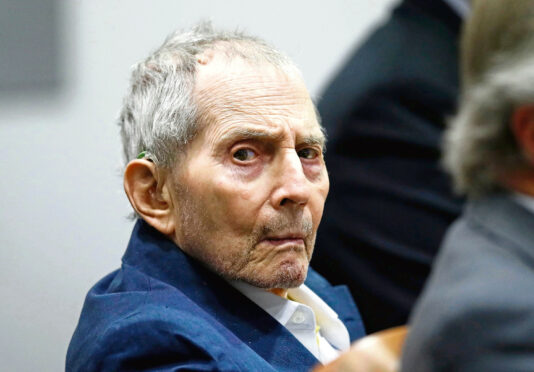
Prosecutors in America will seek an indictment against millionaire property heir Robert Durst over the death of his former wife, Kathie, after her disappearance in 1982, according to sources.
Westchester district attorney Mimi Rocah has decided to take the case to a grand jury, according to a source.
Durst, 78, became notorious around the world after the case inspired The Jinx, an HBO documentary, when he appeared to admit killing people. Last month, in California, he was convicted of murdering a confidante whom prosecutors say helped him cover up his wife’s killing.
The Westchester district attorney’s office previously said it had it reopened the investigation into her death. In a statement issued after Durst’s conviction last month, a spokesperson for Rocah’s office said its investigation was ongoing.
Durst is jailed in Los Angeles and scheduled to be sentenced on October 14 for the 2000 killing of his friend, Susan Berman. His first-degree murder conviction carries a mandatory sentence of life without the possibility of parole.
Durst, the eccentric heir to a family of New York City developers, is now sick and frail. He sat throughout the trial in a wheelchair and spoke slowly in a strained, raspy voice when he testified in his own defence.
Prosecutors say Durst shot Ms Berman at her LA home in December 2000 as she was preparing to tell police about her involvement in Kathie’s death. She had told friends she provided a fake alibi for him after his wife vanished, prosecutors said.
“He’s a narcissistic psychopath. He killed his wife and then he had to keep killing to cover it up,” deputy district attorney John Lewin said after Durst’s conviction in the Los Angeles case.
Kathie Durst was 29 and in her final months of medical school when she vanished on January 31 1982. She and Durst, who was 38 at the time, had been married nearly nine years and were living in South Salem, near the Connecticut border. Her body was never found. At the request of her family, she was declared legally dead in 2017.
He claimed to police that on the night of her disappearance, he had put her on a train to New York, had a drink with a neighbour and then spoke with Kathie by telephone while she stayed at their Manhattan apartment.
They had been arguing earlier in the evening, he said. A few weeks before that, Kathie Durst went to the hospital with facial injuries she said were caused by Robert Durst.
In the 2015 HBO documentary The Jinx: The Life and Deaths of Robert Durst, he admitted he made up the details about seeing his neighbour and talking to Kathie by phone, saying he did so because he was “hoping that would just make everything go away”.
In the same documentary, after filmmakers confronted Durst with evidence linking him to Ms Berman’s killing, he stepped off camera and muttered to himself on a live microphone in the bathroom: “Killed them all, of course.”
Durst, who divorced his missing wife in 1990 citing abandonment, has never been charged over her disappearance despite several efforts over the years to close the case. Authorities reopened the case in 1999, searching a lake and the couple’s home.
While all that was happening, Durst fled to Galveston, Texas, where he was accused of killing a neighbour, Morris Black.
Durst chopped up Black’s body and tossed it out to sea. Durst claimed self-defence – that he and Black were struggling for control of a gun – and was acquitted. He was convicted of destroying evidence for discarding the body parts.
Testifying in the Los Angeles trial, Durst denied killing Kathie.
After her school called to report she had not been going to class, he said he figured she was “out someplace having fun” and suggested perhaps drug use was to blame.
“It hadn’t occurred to me that anything had happened to her,” Durst testified in August. “It was more like: what had Kathie done to Kathie?”

Enjoy the convenience of having The Sunday Post delivered as a digital ePaper straight to your smartphone, tablet or computer.
Subscribe for only £5.49 a month and enjoy all the benefits of the printed paper as a digital replica.
Subscribe